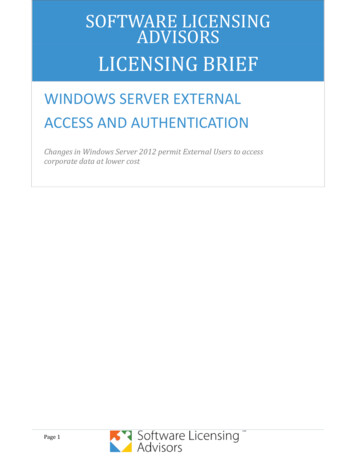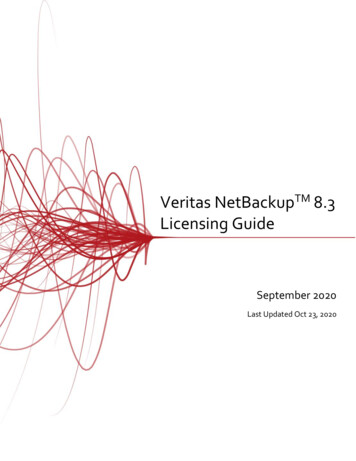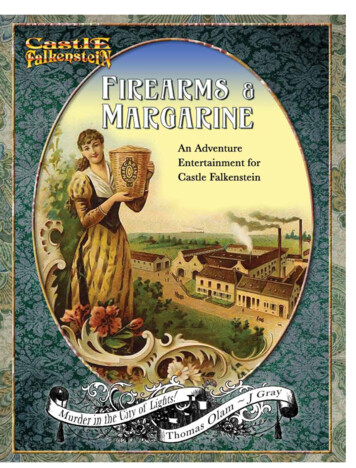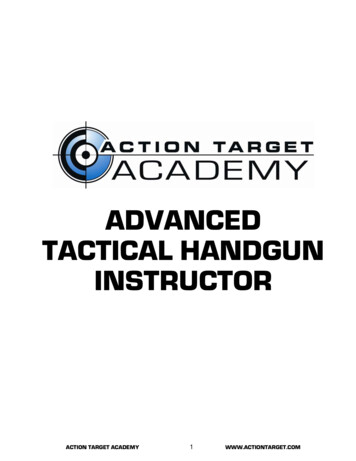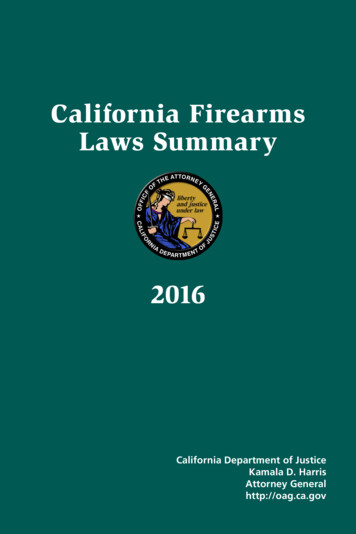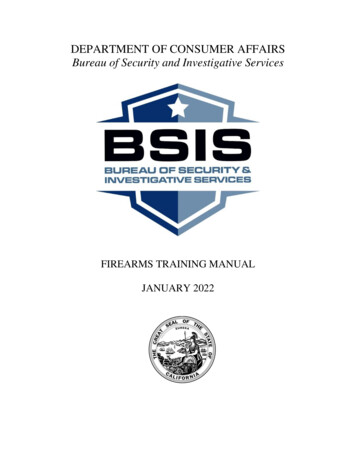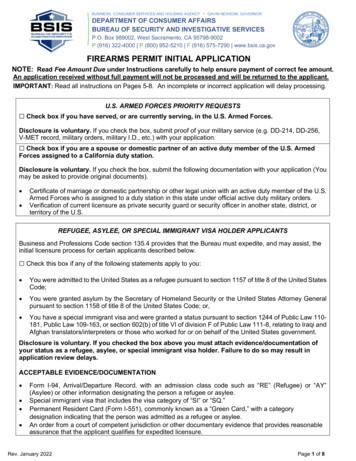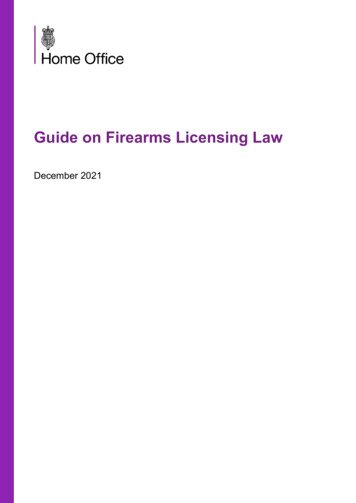
Transcription
Guide on Firearms Licensing LawDecember 2021
Crown copyright 2021This publication is licensed under the terms of the Open Government Licence v3.0 exceptwhere otherwise stated. To view this licence, visit /version/3Where we have identified any third party copyright information you will need to obtainpermission from the copyright holders concerned.
Guide on Firearms Licensing LawContentsChapter 1: An overview – frequently asked questions about firearms licensing3Chapter 2: Definition and Classification of Firearms and Ammunition6Chapter 3: Prohibited Weapons and Ammunition20Chapter 4: Expanding Ammunition30Chapter 5: Restrictions on the Possession, Handling and Distribution of Firearms andAmmunition32Chapter 6: Exemptions from the requirement to hold a certificate40Chapter 7: Young people51Chapter 8: Antique firearms58Chapter 9: Historic handguns63Chapter 10: Firearm Certificate Procedure76Chapter 11: Shot gun Certificate Procedure86Chapter 12: Good reason to possess a firearm93Chapter 13: Law on Shooting Birds and Animals115Chapter 14: Permits130Chapter 15: Registration of firearms dealers133Chapter 16: Museum Firearms Licenses140Chapter 17: Rifle and muzzle-loading pistol clubs, schools and cadet corps145Chapter 18: Security of Firearms and Ammunition155Chapter 19: Fees165Chapter 20: Notices and Appeals170Chapter 21: Criminal use of Firearms174Chapter 22: Law Enforcement179Chapter 23: Proof of Firearms183Chapter 24: Surrender and disposal of firearms and ammunition1851
Guide on Firearms Licensing LawChapter 25: Northern Ireland188Chapter 26: Visitors’ Permit Procedures190Chapter 27: Import and export of firearms and ammunition196Chapter 28: Authorisation of armed guards on UK registered ships201Appendix 1: List of relevant organisations208Appendix 2: List of firearms forms210Appendix 3: Conditions for firearm certificates211Appendix 4: Young persons and firearms law217Appendix 5: Schedule of mass-produced antique air weapons whose production periodpre-dates 1939218Appendix 6: Conditions for registration of firearms dealers221Appendix 7: Guidance on secure keeping of firearms222Appendix 8: Taking of firearms (including air weapons) to Northern Ireland by visitors fromGreat Britain226Appendix 9: Conditions for visitor’s firearm or shot gun permit2227
Guide on Firearms Licensing LawChapter 1: An overview – frequentlyasked questions about firearms licensingWhat is meant by the term ‘firearm’?1.1‘Firearm’ means a lethal barrelled weapon of any description from which any shot,bullet or other missile with kinetic energy of more than one joule at the muzzle ofthe weapon, can be discharged.See Chapter 2 for further details.What are the basic principles of firearms law in GB?1.2GB firearms policy is based on the fact that firearms are dangerous weapons andthe State has a duty to protect the public from their misuse. Gun ownership is aprivilege, not a right. Firearms control in GB is among the toughest in the worldand, as a result, firearms offences continue to make up a small proportion ofrecorded crime.What kind of firearm can be held on certificate?1.3Some firearms and shot guns may be held on a firearm or shot gun certificateissued by the police. Low-powered air weapons are not licensed in England andWales unless they are of a type declared specially dangerous by the Firearms(Dangerous Air Weapons) Rules 1969, but there are restrictions on their sale. An airweapon is “specially dangerous” if it is capable of discharging a missile with kineticenergy in excess, in the case of an air pistol, of 6 foot-pounds or, in the case ofother air weapons,12 foot-pounds. “Specially dangerous” air pistols (and certainother air weapons) are prohibited weapons and may not be held on certificate.See Chapters 10 and 11 (on firearm certificate procedure and shot gun certificateprocedure) for further details.Can anyone apply for a firearm certificate?1.4Permission to possess, purchase or acquire a firearm will only be granted to anindividual who is assessed by the licensing authority, the police, as not posing athreat to public safety and having good reason to own the firearm. Organisationssuch as target shooting clubs, museums and firearms dealers must also apply forlicences if they wish to possess or use firearms. Persons who are sentenced to aterm of imprisonment of three years or more cannot possess a firearm orammunition (including antique firearms) at any time.3
Guide on Firearms Licensing LawSee Chapters 10 and 11 (on firearm certificate procedure and shot gun certificateprocedure) for further details.Who authorises firearm and shot gun certificates?1.5The police are the licensing authority for firearm and shot gun certificates, as wellas for firearms dealers. The authority rests with local police forces rather than acentral licensing authority because of the local information that police will use toinform their judgement. Applications for authority to possess prohibited weapons,such as handguns, in England and Wales are determined by the Home Office onbehalf of the Secretary of State. Applications for such authority in Scotland aredetermined by the Scottish Government on behalf of Scottish Ministers.See Chapters 10, 11 and 15 (on firearm and shot gun certificate procedure and onregistration as a firearms dealer) for further details.What is a ‘good reason’ to own a firearm?1.6Applicants should be able to demonstrate to the police that they require their firearmon a regular, legitimate basis for work, sport or leisure (including collections orresearch). Chief Officers are able to exercise discretion over what constitutes agood reason, judging each case on its own merits.See Chapter 12 for further details.How are firearms stored?1.7The conditions of a firearm or shot gun certificate stipulate that guns must be storedsecurely so as to prevent access by an unauthorised person. The manner in whichthey are stored depends on the individual property and circumstances.See Chapter 18 for further details.What happens to firearms in the event of the death of the owner?1.8In the event of the death of a certificate holder, the person inheriting the effectsmust surrender or declare the weapons to the police or a registered firearms dealer.Failure to do so would result in the inheritor being in breach of the law by having thefirearms in their possession; it is the responsibility of the inheritor to find out whetherfirearms are part of the deceased’s effects. Registered firearms dealers will be ableto advise on the value of the items and how best to proceed in accordance with theinheritor’s wishes. Options include applying for a certificate, selling/transferring thefirearm (for example, to a museum or a certificate holder) or destroying it.See Chapters 5, 14 and 24 for further details.4
Guide on Firearms Licensing LawWhat should I do if I have concerns about a firearm owner?1.9Any concerns should be reported to your local police force.What is the government doing to prevent 3D printed guns beingused?1.10If someone were to possess, purchase, manufacture or sell a firearm or itscomponent parts otherwise than in accordance with the requirements of sections 1,3 and 5 of the Firearms Act 1968, they would be liable to prosecution.See Chapter 3 for more details.Where can I find information about shooting clubs, museums orfirearms dealers?1.11Detailed information about firearms dealers can be found in Chapter 15, museumsin Chapter 16 and shooting clubs in Chapter 17.5
Guide on Firearms Licensing LawChapter 2: Definition and Classification ofFirearms and Ammunition2.1This chapter provides definitions of firearms, component parts, shot guns,deactivated firearms and defectively deactivated firearms, imitation and realisticimitation firearms, including readily convertible imitations, some information onantiques (which are covered more fully in Chapter 8), and firearms conversion. Itgoes on to define various types of firearms and ammunition for which nocertificate is required, including certain types of air weapons.2.2The definitions of ‘firearm’, ‘lethal barrelled weapon’, ‘shot gun’ and ‘ammunition’ forthe purposes of the Firearms Acts are set out in section 57 of the Firearms Act1968 (“the principal Act”) and are set out below. The definition of ‘firearm’ extendsto certain imitation firearms (see paragraphs 2.32 to 2.36).Definition of ‘firearm’ and ‘lethal barrelled weapon’2.3Section 57 of the principal Act (as amended) defines a ‘firearm’ as (i) a lethalbarrelled weapon of any description from which any shot, bullet or other missile canbe discharged with kinetic energy of more than one joule at the muzzle of theweapon (ii) a prohibited weapon (iii) any relevant component part (see below andChapter 12) of such a lethal barrelled or prohibited weapon, and (iv) any accessoryto a lethal barrelled or prohibited weapon designed or adapted to diminish the noiseor flash caused by firing the weapon.Definition of ‘airsoft’ gun2.4An ‘airsoft’ gun as defined in section 57A of the 1968 Act is not regarded as afirearm for the purposes of that Act. Section 57A defines an airsoft gun as abarrelled weapon of any description which is designed to discharge only a smallplastic missile (whether or not it is also capable of discharging any other kind ofmissile) and is not capable of discharging a missile of any kind above thepermitted kinetic energy thresholds at the muzzle of the weapon (see below). A‘small plastic missile’ is defined in section 57A(3) as a missile that:a)is made wholly or partly from plastics;b)is spherical, andc)does not exceed 8 millimetres in diameter.Section 57A(4) sets the maximum permitted kinetic energy levels for airsoft guns at:a)61.3 joules if the weapon is capable of discharging two or moremissiles successively without repeated pressure on the trigger, and
Guide on Firearms Licensing Lawb)2.5 joules in any other case.Definition of ‘relevant component part’2.5A ‘relevant component part’ of a lethal barrelled or prohibited weapon is a firearm inits own right and is defined in section 57(1D) of the 1968 Act as:a) a barrel, chamber or cylinder,b) a frame, body or receiver,c) a breech block, bolt or other mechanism for containing the pressure ofdischarge at the rear of a chamber,but only where the item is capable of being used as a part of a lethal barrelledweapon or a prohibited weapon.Definition of ‘shot gun’2.6A “shot gun” is defined in section 1(3)(a) of the 1968 Act and means a smooth-boregun (not being an air gun) which:a)has a barrel not less than 24 inches in length and does not have any barrelwith a bore exceeding 2 inches in diameter. The length of the barrel ismeasured from the muzzle to the point of ignition (breech face). For amuzzle-loading gun, the point of ignition may be taken as the touch-hole ornipple that is nearest to the breach;b)either has no magazine or has a non-detachable magazine incapable ofholding more than two cartridges (see paragraphs 2.12 to 2.14 for furtherinformation). It should be noted that under section 1(3A) of the 1968 Act agun that has been adapted to have such a magazine only meets this criterionif the magazine bears an approved mark and the adaptation has beencertified in writing either by one of the two Proof Houses or by such otherperson as the Secretary of State has designated, as having been carried outin a manner approved by the Secretary of State; andc)is not a revolver gun (that is, a gun containing a series of chambers, whichrevolve as part of the firing cycle).2.7 When considering the classification of smooth-bore guns, special attention must bepaid to the length of the barrel and the overall length. With the exception of thosechambered for .22 rim-fire cartridges, section 5(1)(ac) of the 1968 Act raised to theprohibited category (see Chapter 3) all self-loading and pump-action models whichare either short-barrelled (under 24 inches) or short in overall length (under 40inches). For the purpose of calculating overall length any detachable, retractable orother movable butt-stock should be disregarded. References to ‘shot guns’ in the1968 Act may be taken generally to mean shot guns which fall within section 2 of thatAct, rather than those subject to sections 1 and 5 of the 1968 Act, unless otherwisestated.7
Guide on Firearms Licensing Law2.8 While overall length is not a relevant factor in regard to the classification of traditionalsingle and double-barrelled smooth-bore guns and repeating shot guns with a bolt orlever-action, any such guns with barrels under 24 inches in length are subject tocontrol under section 1(3)(a)(i) of the 1968 Act. Also controlled under section1(3)(a)(ii) is any repeating shot gun, not otherwise prohibited by virtue of its barrellength or overall length, with a magazine capacity in excess of two cartridges.2.9 Section 5(1)(ad) of the 1968 Act raised to the prohibited category any smooth-borerevolver gun other than one that is chambered for 9mm rim-fire cartridges or is amuzzle-loading revolver gun. The first exemption is understood to cover ‘ratting’ or‘garden’ guns. Since section 1(3)(a) of the 1968 Act does not permit any revolvergun to be regarded as a ‘shot gun’, smooth-bore revolver guns which are chamberedfor 9mm rim-fire or muzzle-loading guns are classed as firearms and subject tocontrol under section 1 of the 1968 Act.2.10 For the purposes only of sections 3(1) and 45(2) of the 1968 Act, and in the definitionof ‘firearms dealer’ in section 57(4), the term ‘shot gun’ also includes any componentpart of a shot gun and any accessory to a shot gun designed or adapted to diminishthe noise or flash caused by firing the gun. For the purposes of all othersections/Acts, the component parts of shot guns are not subject to control under theFirearms Acts. See section 57(4) of the 1968 Act.Definition of ‘ammunition’2.11‘Ammunition’ means ammunition for any firearm and includes grenades, bombsand other like missiles, whether capable of use with a firearm or not; and alsoincludes prohibited ammunition. It should be noted that the definition of ammunitiondoes not include ingredients and components of ammunition; it is only assembledammunition that is controlled under the Act, not component parts. Empty cartridgecases, for example, are not ‘ammunition’. There are two exceptions to this. Thefirst is missiles for ammunition prohibited under section 5 of the 1968 Act, forexample, expanding ammunition which can only be used in a pistol, or armourpiercing bullets. Such missiles are themselves defined as ‘ammunition’ and aresubject to control accordingly (see Chapter 3). The second is primers - section 35of the Violent Crime Reduction Act 2006 introduced controls on the purchase andsale of a cap type primer designed for use in metallic ammunition (see Chapter 5).Proof House certification of adapted shot guns2.128Section 1(3A) of the 1968 Act as amended by section 2(3) of the 1988 Act requiresthat any smooth-bore gun adapted to have a non-detachable magazine incapableof holding more than two cartridges must bear a Proof House mark and have beencertified to that effect. This requirement applies not only to those smooth-boreguns already in circulation which have been adapted, but also to those smoothbore guns which are adapted by the maker subsequent to manufacture but prior todistribution or sale. In both cases such guns are regarded as having been‘adapted’ within the meaning of section 1(3A) of the 1968 Act, which was insertedby 2(3) of the 1988 Act.
Guide on Firearms Licensing Law2.13The marking and certification requirement does not, however, apply in the case ofsmoothbore guns, which are manufactured with a non-detachable magazineincapable of holding more than two cartridges. Such guns are not regarded ashaving been ‘adapted’ within the meaning of section 2(3) since the capacity of themagazine will be secured during the process of manufacture. Although the gunsneed not comply with the Secretary of State’s specifications, the magazine mustmeet the requirement in section 1(3)(a)(ii) of the 1968 Act; that is, the magazinemust be incapable of holding more than two cartridges.2.14When assessing the magazine capacity of a firearm, consideration should begiven to the number of cartridges that the firearm was designed or proofed to take.For example, where a shot gun has a magazine which is capable of holding threecartridges but was designed to hold only two, the shot gun should be considered asection 2 firearm rather than a section 1 firearm. Although interpretation of the lawis ultimately a matter for the courts, it is thought unlikely, for example, that theinsertion of a plastic or wooden plug into a large capacity fixed magazine would, ofitself, be regarded as rendering that gun as having a magazine incapable ofholding more than two cartridges. The restriction would need to be of anequivalent standard to the methods set out in the Home Office approvedspecifications in order to meet the requirements of section 1(3)(a)(ii).Deactivated firearms2.15Within the context of section 38 of the Violent Crime Reduction Act 2006, a‘deactivated firearm’ means an imitation that consists of something which was afirearm but has been rendered incapable of discharging a shot, bullet, or othermissile. Section 8 of the 1988 Act provides that, unless it can be shown otherwise,a firearm which has been deactivated to a standard approved by the Secretary ofState, so that it is incapable of discharging any shot, bullet or other missile, ispresumed not to be a firearm within the meaning of the 1968 Act and therefore isnot subject to control if it bears a mark approved by the Secretary of State fordenoting that fact. The 1988 Act requires that one of the two Proof Houses orsome other person approved by the Secretary of State has marked the firearm andcertified in writing (that is, provided a certificate) that it has been deactivated to theapproved standard. No other person has been approved for this purpose. Adeactivated firearm is also to be treated as an imitation firearm, and by virtue ofsection 24A of the 1968 Act can only be bought by or sold to someone aged 18 orover2.16Deactivation specifications were first set by the Home Office in 1989. They wererevised in 1995 and again in 2010. These specifications came into force on1 October 1995 and 17 December 2010, and are not retrospective. Therefore, agun deactivated to the old specifications prior to revisions, remains deactivatedfor legal purposes.2.17The 1995 (and to some extent 2010) specifications encompassed a substantiallygreater range of firearms design and are generally more stringent than thepreceding (1989) standards.2.18Section 8 of the 1988 Act is an evidential provision and does not preclude thepossibility that a firearm which has been deactivated in some other manner mayalso have ceased to be a firearm within the meaning of the 1968 Act. For example,guns held by museums that were recovered from wrecked ships and aircraft may9
Guide on Firearms Licensing Lawbe corroded to the point that they cannot be fired. This should not be confused withwear or missing parts that can be replaced. The final arbiter of whether the articlefulfils the definition of a firearm for the purposes of section 57(1) of the 1968 Act isa court.EU Firearms Deactivation Regulation2.19An EU Implementing Regulation establishing common guidelines on deactivationstandards and techniques for ensuring that deactivated firearms are renderedirreversibly inoperable came into force on 8 April 2016. These were subsequentlyreviewed with the aim to improve their clarity, avoid any ambiguities forpractitioners, and ensure that the technical specifications were applicable to alltypes of firearms. These revised standards came into force on 28 June 2018 but donot apply to firearms deactivated prior to then unless those firearms are transferredor placed on the market. The Proof Houses have been applying these standards tofirearms submitted to them on or after 28 June 2018. See the gov.uk website forinformation on the current UK standards, which are in line with ImplementingRegulation 2018/337.Defectively deactivated firearms2.20Section 8A of the1988 Act requires the Secretary of State to publish technicalstandards for deactivation. The link in the previous paragraph refers. The Actintroduced a new offence of making a defectively deactivated weapon available forsale or as a gift to another person or to sell it or give it (as a gift) to another person.The offence does not apply if the weapon is made available for sale or as a gift to aperson who is outside of the UK on the basis that if the sale or gift were to takeplace, the weapon would be transferred to a place outside of the UK.2.21An exception under the 1988 Act applies to museums that hold a museum firearmslicence. Such museums can continue to make available for sale or as a gift (as thecase may be), defectively deactivated firearms to another museum firearms licenceholder without the need for the firearms to be deactivated to newer standards.2.22Something is a ‘defectively deactivated weapon’ if:a) it was at any time a firearmb) it has been rendered incapable of discharging any shot, bullet or other missile(and, accordingly, has either ceased to be a firearm or is a firearm only by virtueof the Firearms Act 1982), butc) it has not been rendered so incapable in a way that meets the technicalspecifications for the deactivation of the weapon that apply at the time when theweapon is made available for sale or as a gift or (as the case may be) when it issold or given as a gift.2.2310A person guilty of an offence under this section is, on summary conviction, liable toa term of imprisonment not exceeding 12 months (or, in relation to offencescommitted before paragraph 24(2) of Schedule 22 to the Sentencing Act 2020comes into force, 6 months) or to a fine, or to both. On conviction on indictment,
Guide on Firearms Licensing Lawthe maximum sentence is imprisonment for a term not exceeding 5 years or to afine, or to both.2.24See the gov.uk website for further information on deactivation specifications.Notifying the Home Office of the transfer or possession of adeactivated firearm2.25The Firearms Regulations 2019 require the notification to the Home Office, as therelevant national authority, of possession of a deactivated firearm and their transfer– but only when the transfer is for a period of more than 14 days.2.26Owners of deactivated firearms need to notify the transfer or possession as follows: Deactivated firearms being transferred for a period of 14 days or more,regardless of when they were acquired, need to be notified and the firearm mustmeet current deactivation standards before being transferred. Home Office Circular 010/2019 explains the changes in more detail. There are two forms on GOV.UK to be used for the notification or transfer ofdeactivated firearms. The required information must then be submitted either byemail to: deactivatedfirearmsnotifications@homeoffice.gov.uk or by registeredpost or recorded delivery to:Deactivated Firearms NotificationHome OfficeSerious Violence Unit5th Floor, Fry Building2 Marsham StreetLondonSW1P 4DF2.27It is an offence under regulation 2(1) of The Firearms Regulations 2019 if a persontransfers a deactivated firearm to another person and does not give notice of thetransfer to the appropriate national authority in accordance with regulation 2(2). Aperson guilty of an offence under regulation 2(1) is liable to a fine of up to 200.2.28Under Regulation 3(1), a person in possession of a deactivated firearm for a periodof more than 14 days commits an offence if they fail to give notice of thedeactivated firearm to the appropriate national authority unless the deactivatedfirearm has been transferred to that person and the transfer has already beennotified by the person transferring it. In most instances this will avoid the need forthe same deactivated firearm to be declared twice. Where a person in possessionof a deactivated firearm commits an offence under regulation 3(1), it is a defencefor that person to show that they reasonably believed that the transferor had given,or would give, notice of the transfer in accordance with the arrangements set outwithin regulation 2. A person guilty of an offence under this regulation is liable to alevel 1 fine ( 200).11
Guide on Firearms Licensing LawReadily convertible imitation firearms2.29Section 1 of the Firearms Act 1982 extended the provisions of section 1 of the 1968Act to certain imitation firearms. Therefore, a firearm certificate is required topossess, purchase or acquire an imitation firearm which:a) has the appearance of being a firearm to which section 1 of the 1968 Actapplies; andb) is so constructed or adapted as to be readily convertible into a firearm to whichthat section applies.2.30Under section 1(6) of the 1982 Act, an imitation firearm is regarded as readilyconvertible into a firearm to which section 1 of the 1968 Act applies if:a)it can be converted without any special skill on the part of the personconverting it in the construction or adaptation of firearms of anydescription; andb)the work involved in converting it does not require equipment or toolsother than such as are in common use by persons carrying out works ofconstruction and maintenance in their own homes.Section 1(5) of the 1982 Act provides a defence for a person accused of anoffence to show that he did not know, and had no reason to suspect, that theimitation firearm was so constructed or adapted as to be readily convertible intoa firearm to which section 1 of the Act applies.Guidelines on the 1982 Act2.31Guidelines have been issued which advise on the technical measures that canbe taken to prevent an imitation firearm from being readily convertible into alethal barrelled weapon. These guidelines are intended primarily for the guntrade and are available from representative organisations, such as the GunTrade Association.Offences involving imitation firearms2.32Section 16A of the 1968 Act makes it an offence to possess any firearm or imitationfirearm with intent to cause, or to enable another person to cause, someone else tofear that unlawful violence will be used against them or another person. It providesfor a maximum penalty of 10 years’ imprisonment or a fine, or both.2.33Under section 20 of the 1968 Act it is an offence to trespass with an imitationfirearm. The maximum penalty for such an offence is 6 months imprisonment (fortrespass in a building) or 3 months (for trespass on land). The offence oftrespassing with an imitation firearm in a building (in contrast to the offencecommitted with a firearm as defined by section 57(1) of the 1968 Act) is triable onlysummarily. Section 46(1)(b) of the 1968 Act (police powers of search with awarrant) applies to the seizure of imitation firearms as well as real firearms. SeePart 1 of Schedule 6 to the 1968 for a list of the penalties that apply to the criminaloffences in that Act.12
Guide on Firearms Licensing Law2.34Under section 19 of the 1968 Act, it is an offence for a person to carry an imitationfirearm in a public place without lawful authority or reasonable excuse (see alsoChapter 21). The maximum custodial sentence is 12 months for this offence (as itrelates to imitation firearms).2.35Section 24A of the Firearms Act 1968, as inserted by section 40 of the ViolentCrime Reduction Act, makes it an offence for anyone aged under 18 to purchasean imitation firearm and for anyone to sell an imitation firearm to someone agedunder 18. There is a defence for anyone charged with the offence of selling animitation firearm to someone under 18, where they can show that they hadreasonable grounds for believing the purchaser to be 18 or over.2.36Section 4A of the Firearms Act 1968 makes it an offence for a person, other than aregistered firearms dealer, a) to have in his or her possession or under his or hercontrol an article that is capable of being used (whether by itself or with otherarticles) to convert an imitation firearm into a firearm and, b) the person intends touse the article (whether by itself or with other articles) to convert an imitation firearminto a firearm. A person guilty of an offence under this section is, on summaryconviction, liable to a term of imprisonment not exceeding 12 months (or, in relationto offences committed in England and Wales before paragraph 24(2) of Schedule22 to the Sentencing Act 2020 comes into force, 6 months) or to a fine, or to both.On conviction on indictment, the maximum sentence is imprisonment for a term notexceeding 5 years or to a fine, or to both.Realistic imitation firearms2.37Section 36 of the Violent Crime Reduction Act 2006 makes it an offence for aperson to manufacture, sell, import or cause a realistic imitation firearm to bebrought into Great Britain. The Act also makes it an offence to modify an imitationfirearm so that it becomes a realistic imitation firearm. Section 38(1) defines a‘realistic imitation firearm’ as an imitation firearm which:a) has an appearance that is so realistic as to make it indistinguishable, for allpractical purposes, from a real firearm; andb) is neither a deactivated firearm nor an antique.2.38This definition of ‘realistic imitation firearm’ applies for the purposes of sections 36and 37 of the 2006 Act. The term 'real firearm' is defined in section 38(7) as either afirearm of an actual make or model of a modern firearm, or a generic modernfirearm. The term 'modern firearm' is defined in subsection 8 as a firearm other thanone whose appearance would tend to identify it as having a design and mechanismof a sort first dating before 1870.2.39Section 37 of the 2006 Act provides for a number of specified defences, whichapply for the offence under section 36, where a realistic imitation firearm is madeavailable for one or more of the following purposes:i) for the purposes of
Great Britain 226 Appendix 9: Conditions for visitor’s firearm or shot gun permit 227. Guide on Firearms Licensing Law . 3 . Chapter 1: An overview – frequently asked questions about firearms licensing . if the magazine
